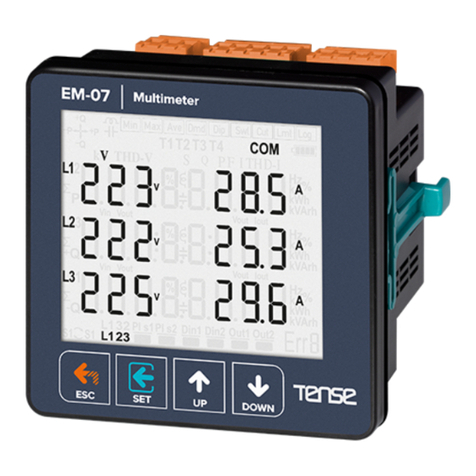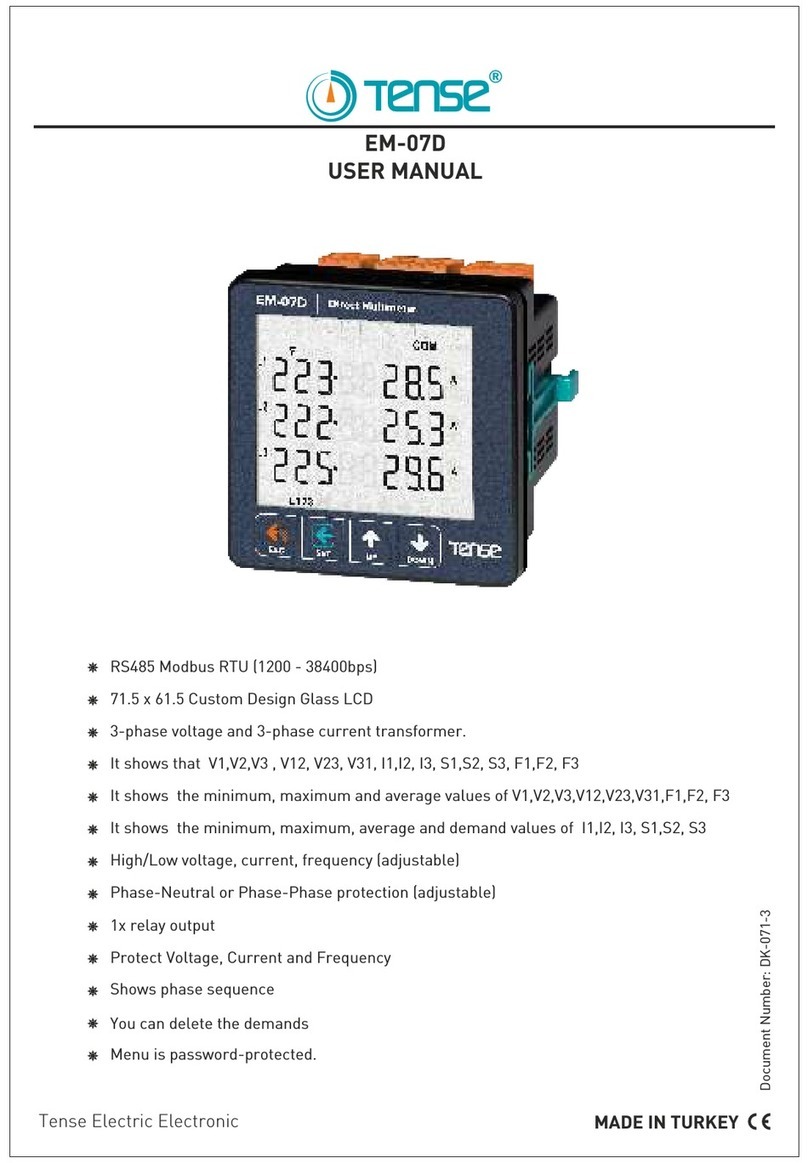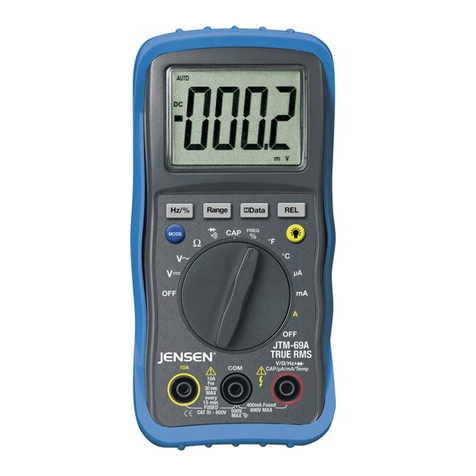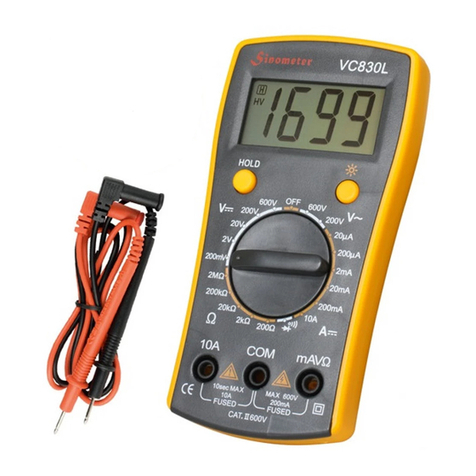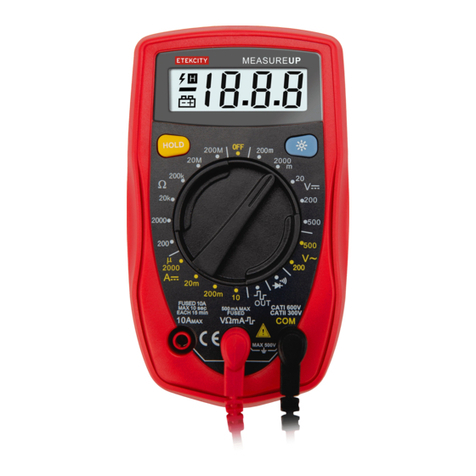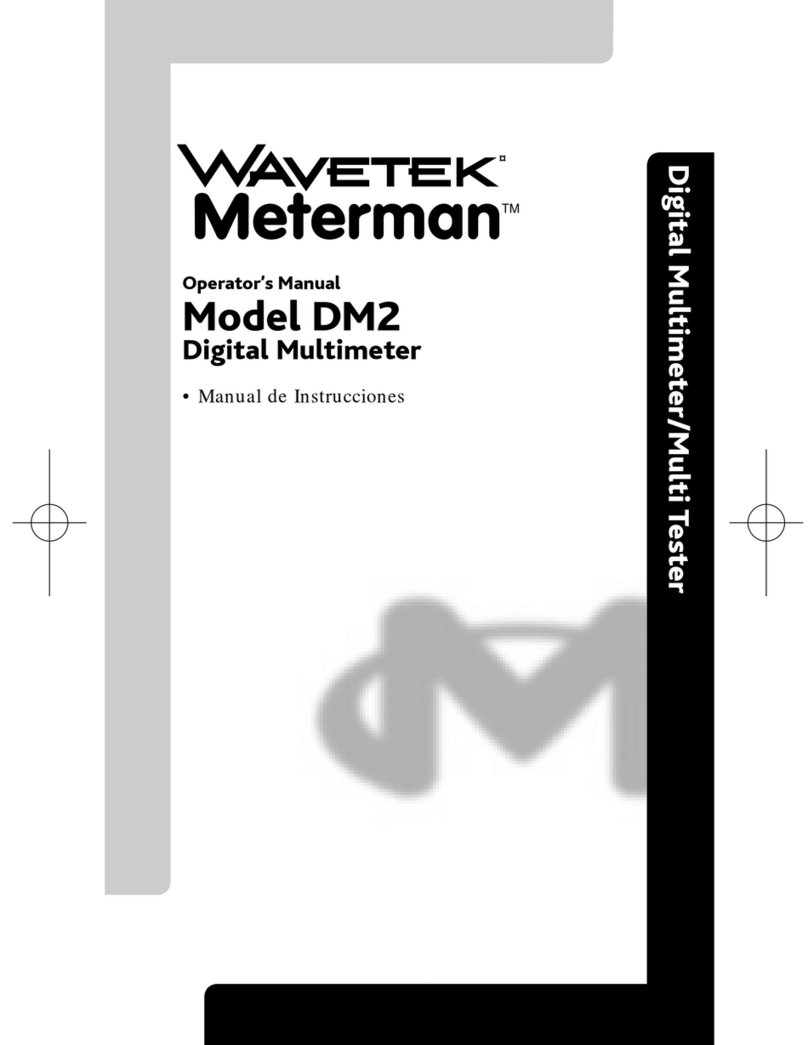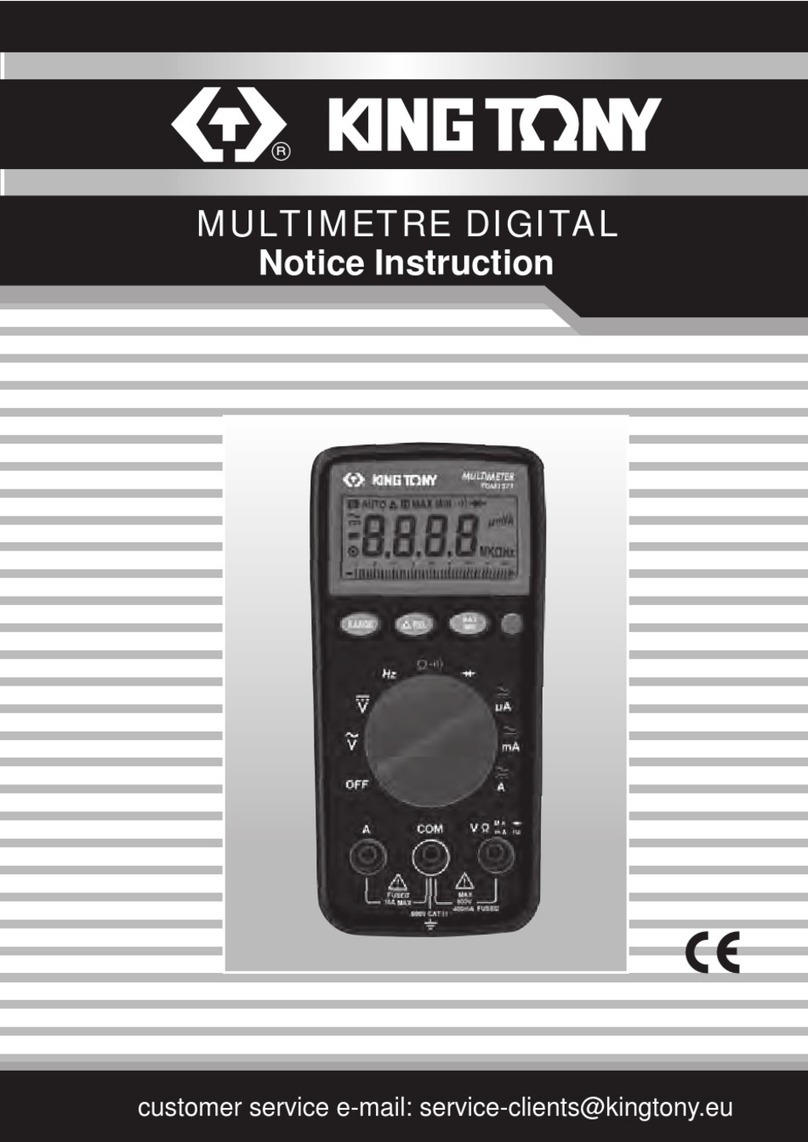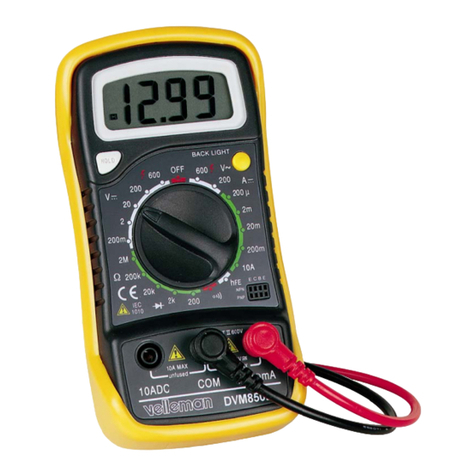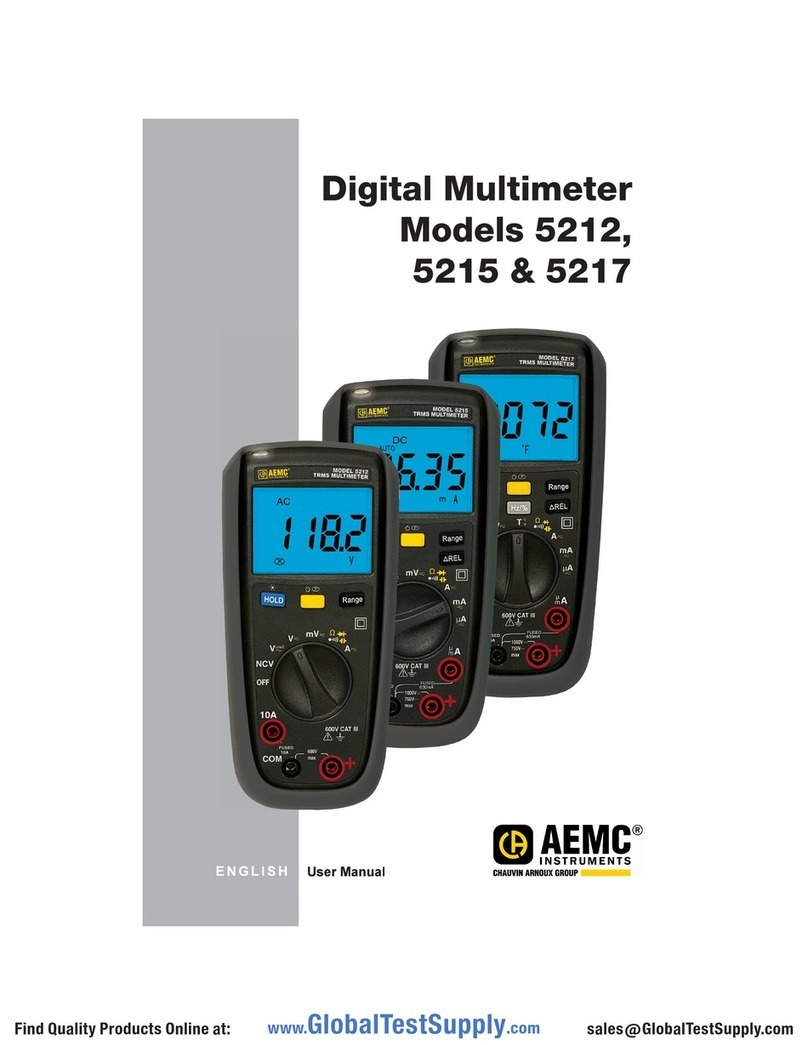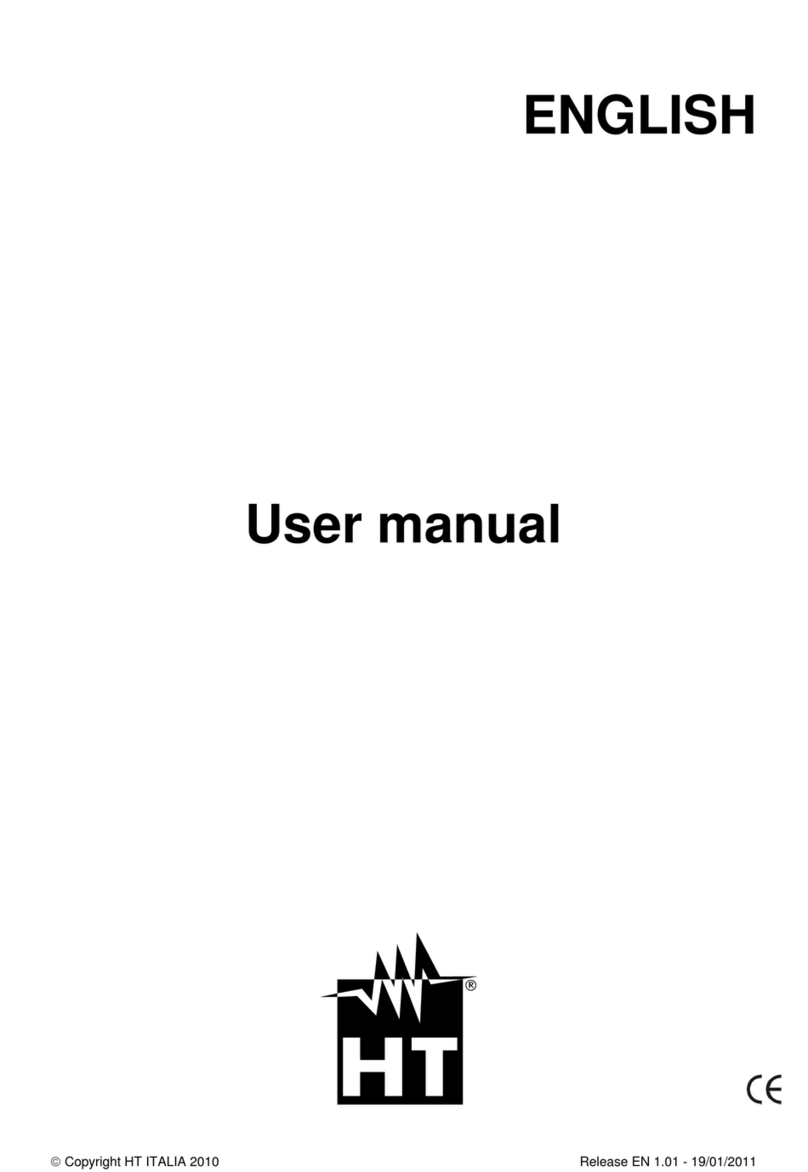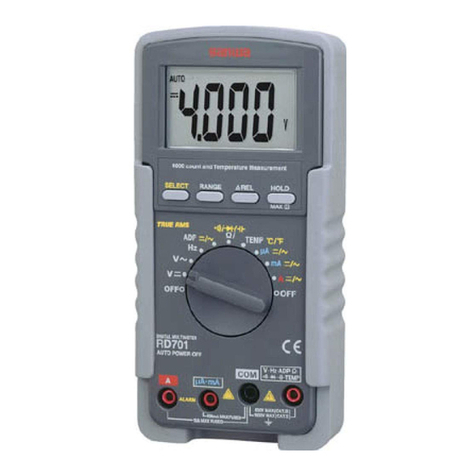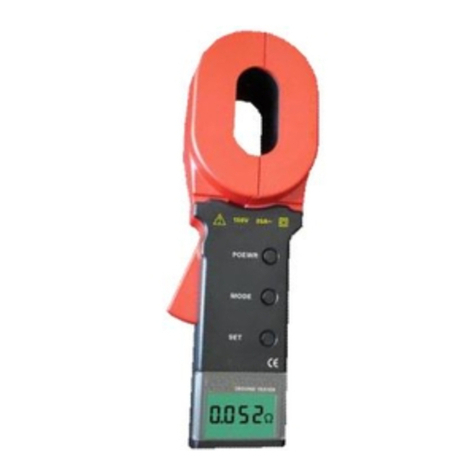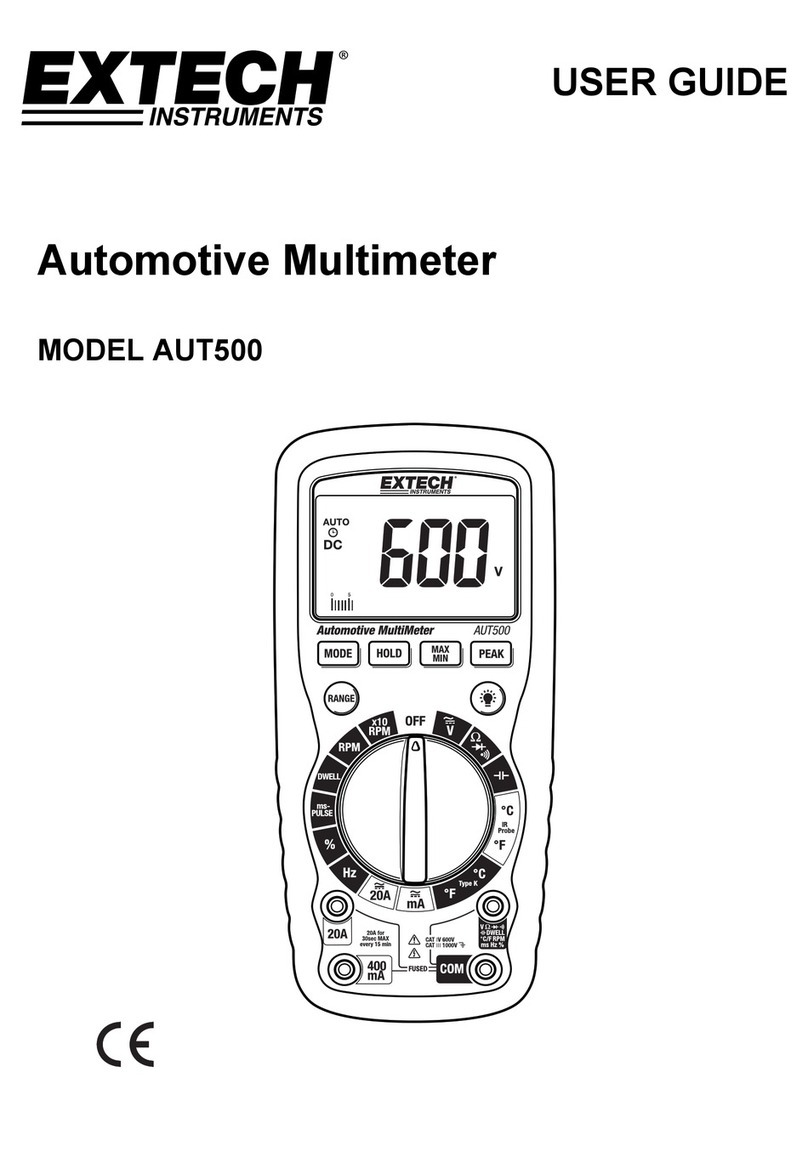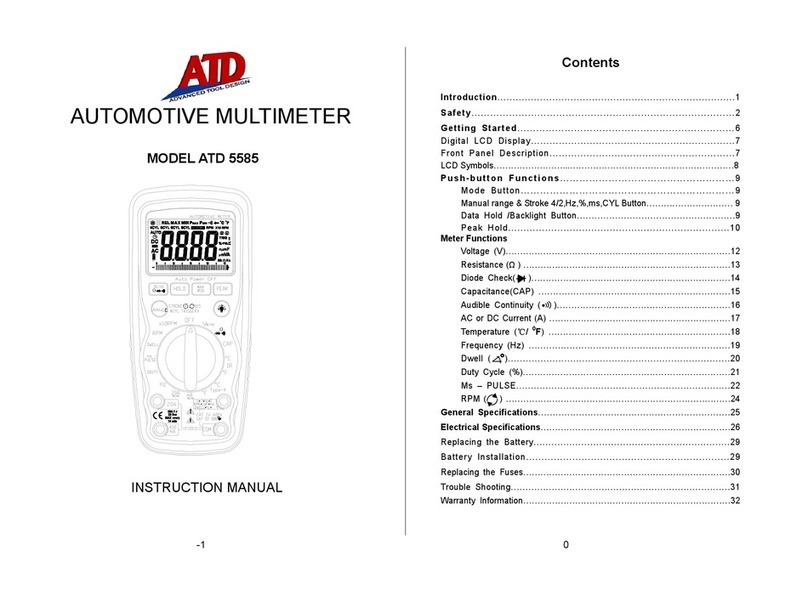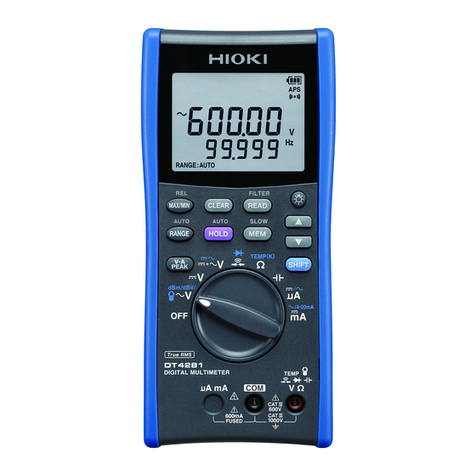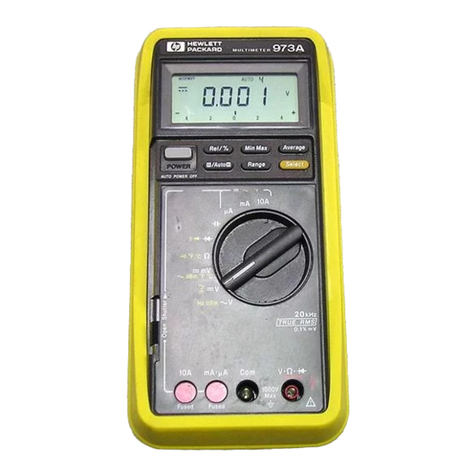Tense EM-07 User manual

RS485 Modbus RTU (1200 - 38400bps)
71.5 x 61.5 Custom Design Glass LCD
3-phase voltage and 3-phase current transformer.
It shows that V1,V2,V3 , V12, V23, V31, I1,I2, I3, S1,S2, S3, F1,F2, F3
It shows the minimum, maximum and average values of V1,V2,V3,V12,V23,V31,F1,F2, F3
It shows the minimum, maximum, average and demand values of I1,I2, I3, S1,S2, S3
High/Low voltage, current, frequency (adjustable)
Phase-Neutral or Phase-Phase protection (adjustable)
1x relay output
You can delete the demands
Menu is password-protected.
Protect Voltage, Current and Frequency
Shows phase sequence
EM-07
USER MANUAL
Tense Electric Electronic MADE IN TURKEY
Document Number: DK-071-3

1 - Connection Diagrams:
-1-
2 - Points to take into consideration in the selection and connection of Current Transformer:
In order to prevent any mistake while connecting the output terminals of the current transformer,
use cables in different colors for each phase or designate a number for each cable.
Keep the cables connected to the output terminals of the current transformer away from the
high-voltage line.
In order to prevent any shake on the current transformer, fix it on the bus-bar, cable or rail.
Be sure that the current transformer value is higher than the maximum current drawn from the
system.
3 - Warnings:
Do not expose the LCD display directly to sunlight in order to avoid any harm on it.
Note that the temperature level on the panel to which the device is mounted is at the range of
operating temperature of the device (-20°C.....55°C)
There must be a space of 5cm behind the device after its installation.
Use the device according to the instructions specified by us.
Fix the device securely to the front-cover of the panel with the apparatus delivered together with the
device.
Place the switch or circuit breaker close to the device or in a location that is easily accessible for the
operator.
Be sure that the panel to which the device is mounted does not operate in a humid environment.
Place a switch or circuit breaker on the system during installation of the device.
Please note that the cables must not be energized during installation.
Flexible monitored and twisted cables must be used for the input and output lines which are not
connected to the mains.
The technical personnel according with the instructions specified in the user's manual must perform
installation of the device and electrical connections.
The feeder cables must be compatible with the requirements of IEC 60227 or IEC 60245
5 - General:
EM-07 Multimeter measures the load on the system and voltage, current, apparent power minimum and
maximum values, demands related to this load on the system.
4 - Maintenance of the Device:
De-energize and disconnect the device. Clean the body of the device with a dry or damp-dry cloth. Do not
use conductive or other chemical substances as a cleaning agent that can damage the device. After
cleaning the device, make its connections and check whether it is working by energizing it.
-2-
Figure-1: 3P4W connection type: 3 phase current and 3 phase voltage and neutral.
N
L1
L2
L3
Load
A1
A2
85-240VAC
50/60Hz. <6VA
BGND A
RS485
COMNC
OUT
5A/250VAC
NO
k3 k2 k1
Curent Transformer Connections
l3 l2 l1
CT1
P1
S1
P2
S2
CT2
P1
S1
P2
S2
CT3
P1
S1
P2
S2
N
Voltage Inputs
L1
L2
L3
Figure-1

1 - Connection Diagrams:
-1-
2 - Points to take into consideration in the selection and connection of Current Transformer:
In order to prevent any mistake while connecting the output terminals of the current transformer,
use cables in different colors for each phase or designate a number for each cable.
Keep the cables connected to the output terminals of the current transformer away from the
high-voltage line.
In order to prevent any shake on the current transformer, fix it on the bus-bar, cable or rail.
Be sure that the current transformer value is higher than the maximum current drawn from the
system.
3 - Warnings:
Do not expose the LCD display directly to sunlight in order to avoid any harm on it.
Note that the temperature level on the panel to which the device is mounted is at the range of
operating temperature of the device (-20°C.....55°C)
There must be a space of 5cm behind the device after its installation.
Use the device according to the instructions specified by us.
Fix the device securely to the front-cover of the panel with the apparatus delivered together with the
device.
Place the switch or circuit breaker close to the device or in a location that is easily accessible for the
operator.
Be sure that the panel to which the device is mounted does not operate in a humid environment.
Place a switch or circuit breaker on the system during installation of the device.
Please note that the cables must not be energized during installation.
Flexible monitored and twisted cables must be used for the input and output lines which are not
connected to the mains.
The technical personnel according with the instructions specified in the user's manual must perform
installation of the device and electrical connections.
The feeder cables must be compatible with the requirements of IEC 60227 or IEC 60245
5 - General:
EM-07 Multimeter measures the load on the system and voltage, current, apparent power minimum and
maximum values, demands related to this load on the system.
4 - Maintenance of the Device:
De-energize and disconnect the device. Clean the body of the device with a dry or damp-dry cloth. Do not
use conductive or other chemical substances as a cleaning agent that can damage the device. After
cleaning the device, make its connections and check whether it is working by energizing it.
-2-
Figure-1: 3P4W connection type: 3 phase current and 3 phase voltage and neutral.
N
L1
L2
L3
Load
A1
A2
85-240VAC
50/60Hz. <6VA
BGND A
RS485
COMNC
OUT
5A/250VAC
NO
k3 k2 k1
Curent Transformer Connections
l3 l2 l1
CT1
P1
S1
P2
S2
CT2
P1
S1
P2
S2
CT3
P1
S1
P2
S2
N
Voltage Inputs
L1
L2
L3
Figure-1

6- Introduction of Home Screen:
State of Measurement; Entry Menu. State of Menu; Entry state of changing parameter.
State of changing parameter; save chance and back to menu state
ESC:
SET:
UP:
DOWN:
State of Measurement; Back to home screen. State of Menu; Exit menu.
State of changing parameter; Not save chance and back to menu state.
State of Error; Manual reset
State of Measurement; To navigate from a main measurement values to another.
State of Menu; To navigate from menu parameters to another.
State of changing parameter; Increase value of parameter
State of Measurement; To navigate from a deep measurement values to another
(min,max,avg, dmd). State of Menu; To navigate from menu parameters to another.
State of changing parameter; Decrease value of parameter
7- Definition of Buttons:
1 - It shows phase number belong to measurement values
2 - Showing values are minimum of measurement values
3 - Showing values are maximum of measurement values
4 - Showing values are average of measurement values
5 - Showing values are demand of measurement values
6 - It shows Serial Communications
7 - It shows that type of measurement values
8 - It shows number of error
9 - It shows relay state. means that relay is close, means that relay is open.
10- It shows phase sequence. “L123” means that phase sequence is correct.”L132” means that phase
sequence is incorrect.
-3-
8- Error Codes:
Err0
Error Code
Err1
Err2
Err3
Err4
Err5
Err6
Err7
Err8
Err9
ErrA
Errb
Phase Sequence ERR
Information
High Voltage ERR
Low Voltage ERR
High Current ERR
Low Current ERR
High Frequency ERR
Low Frequency ERR
Demurrage ERR
Voltage Fuses ERR
Current Fuses ERR
Asymmetry Voltage ERR
Asymmetry Current ERR
If device in any case of error cut off, Relay will be open,
backlight of display will be flashing and bottom right-hand
corner of display will display ERR Code.
Read the warnings before the device is energized. Make sure that the device is connected according to
the connection diagram. When the device energized for the first time, the Home Screen is displayed. Enter
the current transformer ratio and the voltage transformer ratios, if installed, on the settings menu at first.
9 - Start-up of the Device:
Home Screen: It shows voltage and current values together. If protection type is L-N, it shows
phase-neutral voltage else, if protection type is L-L it shows phase-phase voltage. If you use voltage
transformer, it is not showed. The figure-3 is displayed when you press the Down button.
Figure-3: It shows the phase-neutral voltage values. The figure-4 is displayed when you press the
Down button.
Figure-4: It shows the phase-neutral minimum voltage values. The figure-5 is displayed when you press
the Down button.
Figure-5: It shows the phase-neutral maximum voltage values. The figure-6 is displayed when you press
the Down button.
Figure-6: It shows the phase-neutral mean voltage values. The figure-7 is displayed when you press the
Down button.
Figure-7: It shows the phase- phase voltage values. The figure-8 is displayed when you press the Down
button.
Figure-8: It shows the phase- phase minimum voltage values. The figure-9 is displayed when you press
the Down button.
Figure-9: It shows the phase- phase maximum voltage values. The figure-10 is displayed when you press
the Down button.
Figure-10: It shows the phase- phase mean voltage values. The figure-11 is displayed when you press the
Down button.
10 - Display Information:
Figure-3
L1
L2
L3
V
V
V
V
Out1
Figure-7
L12
L23
L31
V
V
V
V
Out1
Figure-4
L1
L2
L3
V
V
V
V
Out1
Figure-8
L12
L23
L31
V
V
V
V
Out1
Figure-5
L1
L2
L3
V
V
V
V
Out1
Figure-9
L12
L23
L31
V
V
V
V
Out1
Figurel-6
L1
L2
L3
V
V
V
V
Out1
Figure-10
L12
L23
L31
V
V
V
V
Out1
-4-
L1
L2
L3
V
A
A
A
Out1
I
Home Screen
1
MinMax AveDm
d
3
2 4 5 6
7
SF I
Err8
8
10
9
Figure-2

6- Introduction of Home Screen:
State of Measurement; Entry Menu. State of Menu; Entry state of changing parameter.
State of changing parameter; save chance and back to menu state
ESC:
SET:
UP:
DOWN:
State of Measurement; Back to home screen. State of Menu; Exit menu.
State of changing parameter; Not save chance and back to menu state.
State of Error; Manual reset
State of Measurement; To navigate from a main measurement values to another.
State of Menu; To navigate from menu parameters to another.
State of changing parameter; Increase value of parameter
State of Measurement; To navigate from a deep measurement values to another
(min,max,avg, dmd). State of Menu; To navigate from menu parameters to another.
State of changing parameter; Decrease value of parameter
7- Definition of Buttons:
1 - It shows phase number belong to measurement values
2 - Showing values are minimum of measurement values
3 - Showing values are maximum of measurement values
4 - Showing values are average of measurement values
5 - Showing values are demand of measurement values
6 - It shows Serial Communications
7 - It shows that type of measurement values
8 - It shows number of error
9 - It shows relay state. means that relay is close, means that relay is open.
10- It shows phase sequence. “L123” means that phase sequence is correct.”L132” means that phase
sequence is incorrect.
-3-
8- Error Codes:
Err0
Error Code
Err1
Err2
Err3
Err4
Err5
Err6
Err7
Err8
Err9
ErrA
Errb
Phase Sequence ERR
Information
High Voltage ERR
Low Voltage ERR
High Current ERR
Low Current ERR
High Frequency ERR
Low Frequency ERR
Demurrage ERR
Voltage Fuses ERR
Current Fuses ERR
Asymmetry Voltage ERR
Asymmetry Current ERR
If device in any case of error cut off, Relay will be open,
backlight of display will be flashing and bottom right-hand
corner of display will display ERR Code.
Read the warnings before the device is energized. Make sure that the device is connected according to
the connection diagram. When the device energized for the first time, the Home Screen is displayed. Enter
the current transformer ratio and the voltage transformer ratios, if installed, on the settings menu at first.
9 - Start-up of the Device:
Home Screen: It shows voltage and current values together. If protection type is L-N, it shows
phase-neutral voltage else, if protection type is L-L it shows phase-phase voltage. If you use voltage
transformer, it is not showed. The figure-3 is displayed when you press the Down button.
Figure-3: It shows the phase-neutral voltage values. The figure-4 is displayed when you press the
Down button.
Figure-4: It shows the phase-neutral minimum voltage values. The figure-5 is displayed when you press
the Down button.
Figure-5: It shows the phase-neutral maximum voltage values. The figure-6 is displayed when you press
the Down button.
Figure-6: It shows the phase-neutral mean voltage values. The figure-7 is displayed when you press the
Down button.
Figure-7: It shows the phase- phase voltage values. The figure-8 is displayed when you press the Down
button.
Figure-8: It shows the phase- phase minimum voltage values. The figure-9 is displayed when you press
the Down button.
Figure-9: It shows the phase- phase maximum voltage values. The figure-10 is displayed when you press
the Down button.
Figure-10: It shows the phase- phase mean voltage values. The figure-11 is displayed when you press the
Down button.
10 - Display Information:
Figure-3
L1
L2
L3
V
V
V
V
Out1
Figure-7
L12
L23
L31
V
V
V
V
Out1
Figure-4
L1
L2
L3
V
V
V
V
Out1
Figure-8
L12
L23
L31
V
V
V
V
Out1
Figure-5
L1
L2
L3
V
V
V
V
Out1
Figure-9
L12
L23
L31
V
V
V
V
Out1
Figurel-6
L1
L2
L3
V
V
V
V
Out1
Figure-10
L12
L23
L31
V
V
V
V
Out1
-4-
L1
L2
L3
V
A
A
A
Out1
I
Home Screen
1
MinMax AveDm
d
3
2 4 5 6
7
SF I
Err8
8
10
9
Figure-2

-5-
Figure-21: It shows the frequency values of each phase. The figure-22 is displayed when you press the
Down button.
Figure-22: It shows the minimum frequency values of each phase. The figure-23 is displayed when you
press the Down button.
Figure-23: It shows the maximum frequency values of each phase. The figure-24 is displayed when you
press the Down button.
Figure-24: It shows the mean frequency values of each phase. The Home Screen is displayed when you
press the Down button.
L1
L2
L3
F
Out1
Hz
Hz
Hz
Figure-21
F
Out1
Hz
Hz
Hz
Figure-22
F
Out1
Hz
Hz
Hz
Figure-23
F
Out1
Hz
Hz
Hz
Figure-24
Figure-16: It shows the apparent power values of each phase. The figure-17 is displayed when you press
the Down button.
Figure-17: It shows the minimum apparent power values of each phase. The figure-18 is displayed when
you press the Down button.
Figure-18: It shows the maximum apparent power values of each phase. The figure-19 is displayed when
you press the Down button.
Figure-19: It shows the mean apparent power values of each phase. The figure-20 is displayed when you
press the Down button.
Figure-20: It shows the apparent power demand values of each phase. The figure-21 is displayed when
you press the Down button.
Figure-16
L1
L2
L3
S
kVA
kVA
kVA
Out1
Figure-18
L1
L2
L3
S
kVA
kVA
kVA
Out1
S
kVA
kVA
kVA
Out1
Şekil-20
S
L1
L2
L3
kVA
kVA
kVA
Out1
Figure-19
S
L1
L2
L3
kVA
kVA
kVA
Out1
Figure-17
L1
L2
L3
L1
L2
L3
I
A
A
A
Out1
L1
L2
L3
I
A
A
A
Out1
L1
L2
L3
I
A
A
A
Out1
L1
L2
L3
I
A
A
A
Out1
L1
L2
L3
I
A
A
A
Out1
Figure-11 Figure-12 Figure-13 Figure-15
Figure-14
Figure-11: It shows the current values of each phase. The figure-12 is displayed when you press the
Down button.
Figure-12: It shows the minimum current values of each phase. The figure-13 is displayed when you
press the Down button.
Figure-13: It shows the maximum current values of each phase. The figure-14 is displayed when you
press the Down button.
Figure-14: It shows the mean current values of each phase. The figure-15 is displayed when you press
the Down button.
Figure-15: It shows the current demand current values of each phase. The figure-16 is displayed when
you press the Down button.
-6-
Figure-31 Figure-30
Figure-27 Figure-28
Figure-25: Press Menu button to enter password section. The figure-26 is displayed when you enter
password and press the Menu button.
Figure-26: It uses for voltage settings. The figure-27 is displayed when you press the UP button.
Figure-27: It uses for current settings. The figure-28 is displayed when you press the UP button.
Figure-28: It uses for frequency settings. The figure-29 is displayed when you press the UP button.
Figure-29: It uses for RS-485 settings. The figure-30 is displayed when you press the UP button.
Figure-30: It uses for general settings. The figure-31 is displayed when you press the UP button.
Figure-31: It uses for about the device. This section give a information about device serial number and
version number. You can use ESC button for exit menu.
Figure-25
Figure-26
12 - Settings:
Figure-29
Set
The Home screen is displayed, when the device is energized. When you press the up button to see the
other data on the display, the next data is displayed (Figure-3). The figure-7 is displayed when you press the
Up button. The figure-11 is displayed when you press the Up button. The figure-16 is displayed when you
press the Up button. The figure-21 is displayed when you press the Up button. The screen back to
Home Screen when you press the Up button.
If you want to see values of min,max,mean and demand you can use down button. If you back to
home screen in anywhere, you can use ESC button.
11 - To advance in Display Inventory:
L1
L2
L3
V
A
A
A
Out1
Home
Screen
Figure-3
L12
L23
L31
V
V
V
V
Out1
Figure-7
L1
L2
L3
I
A
A
A
Out1
Figure-11
L1
L2
L3
F
Out1
Hz
Hz
Hz
Figure-21
L1
L2
L3
S
Var
Var
Var
Out1
Din1
Figure-16
I
L1
L2
L3
V
V
V
V
Out1

-5-
Figure-21: It shows the frequency values of each phase. The figure-22 is displayed when you press the
Down button.
Figure-22: It shows the minimum frequency values of each phase. The figure-23 is displayed when you
press the Down button.
Figure-23: It shows the maximum frequency values of each phase. The figure-24 is displayed when you
press the Down button.
Figure-24: It shows the mean frequency values of each phase. The Home Screen is displayed when you
press the Down button.
L1
L2
L3
F
Out1
Hz
Hz
Hz
Figure-21
F
Out1
Hz
Hz
Hz
Figure-22
F
Out1
Hz
Hz
Hz
Figure-23
F
Out1
Hz
Hz
Hz
Figure-24
Figure-16: It shows the apparent power values of each phase. The figure-17 is displayed when you press
the Down button.
Figure-17: It shows the minimum apparent power values of each phase. The figure-18 is displayed when
you press the Down button.
Figure-18: It shows the maximum apparent power values of each phase. The figure-19 is displayed when
you press the Down button.
Figure-19: It shows the mean apparent power values of each phase. The figure-20 is displayed when you
press the Down button.
Figure-20: It shows the apparent power demand values of each phase. The figure-21 is displayed when
you press the Down button.
Figure-16
L1
L2
L3
S
kVA
kVA
kVA
Out1
Figure-18
L1
L2
L3
S
kVA
kVA
kVA
Out1
S
kVA
kVA
kVA
Out1
Şekil-20
S
L1
L2
L3
kVA
kVA
kVA
Out1
Figure-19
S
L1
L2
L3
kVA
kVA
kVA
Out1
Figure-17
L1
L2
L3
L1
L2
L3
I
A
A
A
Out1
L1
L2
L3
I
A
A
A
Out1
L1
L2
L3
I
A
A
A
Out1
L1
L2
L3
I
A
A
A
Out1
L1
L2
L3
I
A
A
A
Out1
Figure-11 Figure-12 Figure-13 Figure-15
Figure-14
Figure-11: It shows the current values of each phase. The figure-12 is displayed when you press the
Down button.
Figure-12: It shows the minimum current values of each phase. The figure-13 is displayed when you
press the Down button.
Figure-13: It shows the maximum current values of each phase. The figure-14 is displayed when you
press the Down button.
Figure-14: It shows the mean current values of each phase. The figure-15 is displayed when you press
the Down button.
Figure-15: It shows the current demand current values of each phase. The figure-16 is displayed when
you press the Down button.
-6-
Figure-31 Figure-30
Figure-27 Figure-28
Figure-25: Press Menu button to enter password section. The figure-26 is displayed when you enter
password and press the Menu button.
Figure-26: It uses for voltage settings. The figure-27 is displayed when you press the UP button.
Figure-27: It uses for current settings. The figure-28 is displayed when you press the UP button.
Figure-28: It uses for frequency settings. The figure-29 is displayed when you press the UP button.
Figure-29: It uses for RS-485 settings. The figure-30 is displayed when you press the UP button.
Figure-30: It uses for general settings. The figure-31 is displayed when you press the UP button.
Figure-31: It uses for about the device. This section give a information about device serial number and
version number. You can use ESC button for exit menu.
Figure-25
Figure-26
12 - Settings:
Figure-29
Set
The Home screen is displayed, when the device is energized. When you press the up button to see the
other data on the display, the next data is displayed (Figure-3). The figure-7 is displayed when you press the
Up button. The figure-11 is displayed when you press the Up button. The figure-16 is displayed when you
press the Up button. The figure-21 is displayed when you press the Up button. The screen back to
Home Screen when you press the Up button.
If you want to see values of min,max,mean and demand you can use down button. If you back to
home screen in anywhere, you can use ESC button.
11 - To advance in Display Inventory:
L1
L2
L3
V
A
A
A
Out1
Home
Screen
Figure-3
L12
L23
L31
V
V
V
V
Out1
Figure-7
L1
L2
L3
I
A
A
A
Out1
Figure-11
L1
L2
L3
F
Out1
Hz
Hz
Hz
Figure-21
L1
L2
L3
S
Var
Var
Var
Out1
Din1
Figure-16
I
L1
L2
L3
V
V
V
V
Out1

13.1 - Voltage Settings:
-7-
Pr.1: High Voltage Protection Value
Pr.2: High Voltage Protection Delay time
Pr.3: High Voltage Protection Reset time
Pr.4: High Voltage Protection Hysteresis
Pr.5: High Voltage Protection Enable/Disable
Pr.6: Low Voltage Protection Value
Pr.7: Low Voltage Protection Delay time
Pr.8: Low Voltage Protection Reset time
Pr.9: Low Voltage Protection Hysteresis
Pr.10: Low Voltage Protection Enable/Disable
Pr.11: Voltage Asymmetry Protection Value
Pr.12: Voltage Asymmetry Protection Delay Time
Pr.13: Voltage Asymmetry Protection Reset Time
Pr.14: Voltage Asymmetry Protection Hysteresis
Pr.15: Voltage Asymmetry Protection Enable/Disable
Pr.16: Voltage Auto Reset Enable/Disable
Pr.17: Voltage Transformer Ratio
Pr.18: Voltage Fuses Enable/Disable
Pr.19: Voltage Protection Type
Figure-33Figure-32
Set
Esc
V
Figure-42
Figure-43
Figure-34
Figure-35
Figure-36
Figure-37
Figure-38
Figure-39
V
V
Figure-40
V
Figure-41
Press Menu button and enter password (Default Password =0000)
to enter program list. The figure-26 is displayed when you enter
password and press the Menu button. You enter Voltage set when
you press Menu button. If you enter voltage set menu, the figure-32
displayed. This menu have 19 different voltage set value. When you
press the up button to see the other voltage set values on the display,
the next data is displayed. The figure-32 is displayed when you press
the up button after the Pr.19 is displayed. By using up-down buttons
select the program. Press Menu to enter required program.
By up-down buttons, you can set the program. Press Menu to record
your settings, if you press ESC button, you cannot record your settings.
Figure-26
Figure-48
Figure-47
Figure-46
Figure-45
Figure-49
Figure-44
Figure-50
Figure-38
Figure-36
Figure-35
V
V
Figure-32
Pr.1 : High Voltage Protection Value: Determines the maximum operating voltage
value of load.
Default: 250V, Min: 1V, Max: 300V
Pr.6: Low Voltage Protection Value: Determines the minimum operating voltage value
of load.
Default: 170V, Min: 1V, Max: 300V
Figure-33
Pr.2: High Voltage Protection Delay Time: Determines delay open time. Delay time for
activating the output. If any voltage exceeds high voltage protect value, Relay output
switches open at the end of delay time.
Default: 3sec, Min: 1sec, Max: 10000sec.
Pr.7: Low Voltage Protection Delay Time : Determines delay open time. Delay time for
activating the output. If any voltage over the low voltage protect value, Relay output
switches open at the end of delay time.
Default: 3sec, Min: 1sec, Max: 10000sec.
Figure-34
Pr.3: High Voltage Protection Reset Time: Determines delay close time. If all voltage
below the high voltage protect value as a hysteresis voltage , relay output switches close
at the end of the reset time.
Default: 3sec, Min: 1sec, Max: 10000sec.
Pr.8: Low Voltage Protection Reset Time: Determines delay close time.If all voltage
below the low voltage protect value as a hysteresis voltage , relay output switches close
at the end of the reset time.
Default: 3sec, Min: 1sec, Max: 10000sec.
Pr.4: High Voltage Protection Hysteresis: Required hysteresis voltage for high voltage
warning is programmed.
Default: 5V, Min: 1V, Max: 200V
Pr.9: Low Voltage Protection Hysteresis: Required hysteresis voltage for low voltage
warning is programmed.
Default: 5V, Min: 1V, Max: 200V
Pr.5: High Voltage Protection Enable/Disable: Determines Enable or Disable the high
voltage protection.
Default: Enable, Min: Disable, Max: Enable
Pr.10: Low Voltage Protection Enable/Disable: Determines Enable or Disable the low
voltage protection.
Default: Enable, Min: Disable, Max: Enable
Figure-37
V
Figure-39
Figure-40
V
Figure-41
-8-

13.1 - Voltage Settings:
-7-
Pr.1: High Voltage Protection Value
Pr.2: High Voltage Protection Delay time
Pr.3: High Voltage Protection Reset time
Pr.4: High Voltage Protection Hysteresis
Pr.5: High Voltage Protection Enable/Disable
Pr.6: Low Voltage Protection Value
Pr.7: Low Voltage Protection Delay time
Pr.8: Low Voltage Protection Reset time
Pr.9: Low Voltage Protection Hysteresis
Pr.10: Low Voltage Protection Enable/Disable
Pr.11: Voltage Asymmetry Protection Value
Pr.12: Voltage Asymmetry Protection Delay Time
Pr.13: Voltage Asymmetry Protection Reset Time
Pr.14: Voltage Asymmetry Protection Hysteresis
Pr.15: Voltage Asymmetry Protection Enable/Disable
Pr.16: Voltage Auto Reset Enable/Disable
Pr.17: Voltage Transformer Ratio
Pr.18: Voltage Fuses Enable/Disable
Pr.19: Voltage Protection Type
Figure-33Figure-32
Set
Esc
V
Figure-42
Figure-43
Figure-34
Figure-35
Figure-36
Figure-37
Figure-38
Figure-39
V
V
Figure-40
V
Figure-41
Press Menu button and enter password (Default Password =0000)
to enter program list. The figure-26 is displayed when you enter
password and press the Menu button. You enter Voltage set when
you press Menu button. If you enter voltage set menu, the figure-32
displayed. This menu have 19 different voltage set value. When you
press the up button to see the other voltage set values on the display,
the next data is displayed. The figure-32 is displayed when you press
the up button after the Pr.19 is displayed. By using up-down buttons
select the program. Press Menu to enter required program.
By up-down buttons, you can set the program. Press Menu to record
your settings, if you press ESC button, you cannot record your settings.
Figure-26
Figure-48
Figure-47
Figure-46
Figure-45
Figure-49
Figure-44
Figure-50
Figure-38
Figure-36
Figure-35
V
V
Figure-32
Pr.1 : High Voltage Protection Value: Determines the maximum operating voltage
value of load.
Default: 250V, Min: 1V, Max: 300V
Pr.6: Low Voltage Protection Value: Determines the minimum operating voltage value
of load.
Default: 170V, Min: 1V, Max: 300V
Figure-33
Pr.2: High Voltage Protection Delay Time: Determines delay open time. Delay time for
activating the output. If any voltage exceeds high voltage protect value, Relay output
switches open at the end of delay time.
Default: 3sec, Min: 1sec, Max: 10000sec.
Pr.7: Low Voltage Protection Delay Time : Determines delay open time. Delay time for
activating the output. If any voltage over the low voltage protect value, Relay output
switches open at the end of delay time.
Default: 3sec, Min: 1sec, Max: 10000sec.
Figure-34
Pr.3: High Voltage Protection Reset Time: Determines delay close time. If all voltage
below the high voltage protect value as a hysteresis voltage , relay output switches close
at the end of the reset time.
Default: 3sec, Min: 1sec, Max: 10000sec.
Pr.8: Low Voltage Protection Reset Time: Determines delay close time.If all voltage
below the low voltage protect value as a hysteresis voltage , relay output switches close
at the end of the reset time.
Default: 3sec, Min: 1sec, Max: 10000sec.
Pr.4: High Voltage Protection Hysteresis: Required hysteresis voltage for high voltage
warning is programmed.
Default: 5V, Min: 1V, Max: 200V
Pr.9: Low Voltage Protection Hysteresis: Required hysteresis voltage for low voltage
warning is programmed.
Default: 5V, Min: 1V, Max: 200V
Pr.5: High Voltage Protection Enable/Disable: Determines Enable or Disable the high
voltage protection.
Default: Enable, Min: Disable, Max: Enable
Pr.10: Low Voltage Protection Enable/Disable: Determines Enable or Disable the low
voltage protection.
Default: Enable, Min: Disable, Max: Enable
Figure-37
V
Figure-39
Figure-40
V
Figure-41
-8-

Figure-50
Figure-45
Figure-44
Figure-43
Figure-42
Pr.11: Voltage Asymmetry Protection Value : Determines the controlled voltage
asymmetry. Asymmetry Ratio Adjusment: Device calculates a value by dividing
difference between highest and lowest phase value to highest phase value.
Asymmetry Ratio = [(Highest Voltage – Lowest Voltage) / Highest Voltage ] x 100
Default: %20, Min: %5, Max: %30
Pr.16: Voltage Auto Reset Enable/Disable: If auto reset enable and system into error,
if all voltage are over/below the protect value as hysteresis value ,relay output switches
on at the end of the Reset time. If Auto reset is disable, after all voltage are over/below
hysteresis value, relay output switches manually. (Using ESC button).
Default: Enable, Min: Disable, Max: Enable
Pr.12: Voltage Asymmetry Protection Delay time: Determines delay open time. Delay
time for activating the output. If calculated asymmetry value below the voltage
asymmetry protect value, Relay output switches open at the end of delay time.
Default: 3sec, Min: 1sec, Max: 10000sec.
Pr.17: Voltage Transformer Ratio: If you use medium voltage , you can use VTR
Default: 1, Min: 1, Max: 999
Pr.13: Voltage Asymmetry Protection Reset Time: Determines delay close time.
If calculated asymmetry value over the voltage asymmetry protect value as a hysteresis
voltage , relay output switches close at the end of the reset time.
Default: 3sec, Min: 1sec, Max: 10000sec.
Pr.18: Voltage Fuses Enable/Disable: If any phase voltage exceeds 1.5 times of high
voltage protect values, or ,if any phase voltage decrease 0.5 times of low voltage protect
value, the relay switches off instantly. At position disable, voltage fuses function is
cancelled.
Default: Disable, Min: Disable, Max: Enable
Pr.14: Voltage Asymmetry Protection Hysteresis: Required hysteresis voltage for
voltage asymmetry warning is programmed.
Default: %2, Min: %1, Max: %10
Pr.19: Voltage Protection Type: Voltage Protection can be selected as L-N or L-L in
this menu. Phase-Neutral voltage protection can be implemented if the “L-N” protection
is selected. Phase-Phase voltage protection can be implemented if the “L-L” protection
is selected.
Default: L-n, Min: L-n, Max: L-L
Pr.15: Voltage Asymmetry Protection Enable/Disable: Determines Enable or Disable
the voltage asymmetry protection.
Default: Enable, Min: Disable, Max: Enable
Figure-46
Figure-47
Figure-48
Figure-49
-9-
Figure-71
Figure-70
Figure-69
Figure-68
Figure-67
Figure-66
Figure-65
Figure-61
Figure-60
Figure-59
V
Figure-58
Figure-56
A
Figure-55
Figure-54
A
Figure-52Figure-51
A
Figure-27
13.2 - Current Settings:
-10-
Pr.20: High Current Protection Value
Pr.21: High Current Protection Delay Time
Pr.22: High Current Protection Reset Time
Pr.23: High Current Protection Hysteresis
Pr.24: High Current Protection Enable/Disable
Pr.25: Low Current Protection Value
Pr.26: Low Current Protection Delay Time
Pr.27: Low Current Protection Reset Time
Pr.28: Low Current Protection Hysteresis
Pr.29: Low Current Protection Enable/Disable
Pr.30: Current Asymmetry Protection Value
Pr.31: Current Asymmetry Protection Delay Time
Pr.32: Current Asymmetry Protection Reset Time
Pr.33: Current Asymmetry Protection Hysteresis
Pr.34: Current Asymmetry Protection Enable/Disable
Pr.35: Current Auto Reset Enable/Disable
Pr.36: Current Transformer Ratio
Pr.37: Current Fuses Enable/Disable
Pr.38: Demurrage Protection Enable/Disable
Pr.39: Demurrage Protection Time
Pr.40: Demurrage Protection Factor
Set
Esc
Figure-53
Press Menu button and enter password (Default Password =0000)
to enter program list. The figure-26(Voltage SET) is displayed when
you enter password and press the Menu button. The figure-27
(Current SET) is displayed when you press the up button. You enter
Current set when you press Menu button. If you enter Current set
menu, the figure-51(Pr.20) displayed. This menu have 21 different
current set value. When you press the up button to see the other
current set values on the display, the next data is displayed. The
figure-51 is displayed when you press the up button after the Pr.40
is displayed. By using up-down buttons select the program. Press
Menu to enter required program. By up-down buttons, you can set
the program. Press Menu to record your settings, if you press ESC
button, you cannot record your settings.
Figure-57
Figure-62Figure-64 Figure-63

Figure-50
Figure-45
Figure-44
Figure-43
Figure-42
Pr.11: Voltage Asymmetry Protection Value : Determines the controlled voltage
asymmetry. Asymmetry Ratio Adjusment: Device calculates a value by dividing
difference between highest and lowest phase value to highest phase value.
Asymmetry Ratio = [(Highest Voltage – Lowest Voltage) / Highest Voltage ] x 100
Default: %20, Min: %5, Max: %30
Pr.16: Voltage Auto Reset Enable/Disable: If auto reset enable and system into error,
if all voltage are over/below the protect value as hysteresis value ,relay output switches
on at the end of the Reset time. If Auto reset is disable, after all voltage are over/below
hysteresis value, relay output switches manually. (Using ESC button).
Default: Enable, Min: Disable, Max: Enable
Pr.12: Voltage Asymmetry Protection Delay time: Determines delay open time. Delay
time for activating the output. If calculated asymmetry value below the voltage
asymmetry protect value, Relay output switches open at the end of delay time.
Default: 3sec, Min: 1sec, Max: 10000sec.
Pr.17: Voltage Transformer Ratio: If you use medium voltage , you can use VTR
Default: 1, Min: 1, Max: 999
Pr.13: Voltage Asymmetry Protection Reset Time: Determines delay close time.
If calculated asymmetry value over the voltage asymmetry protect value as a hysteresis
voltage , relay output switches close at the end of the reset time.
Default: 3sec, Min: 1sec, Max: 10000sec.
Pr.18: Voltage Fuses Enable/Disable: If any phase voltage exceeds 1.5 times of high
voltage protect values, or ,if any phase voltage decrease 0.5 times of low voltage protect
value, the relay switches off instantly. At position disable, voltage fuses function is
cancelled.
Default: Disable, Min: Disable, Max: Enable
Pr.14: Voltage Asymmetry Protection Hysteresis: Required hysteresis voltage for
voltage asymmetry warning is programmed.
Default: %2, Min: %1, Max: %10
Pr.19: Voltage Protection Type: Voltage Protection can be selected as L-N or L-L in
this menu. Phase-Neutral voltage protection can be implemented if the “L-N” protection
is selected. Phase-Phase voltage protection can be implemented if the “L-L” protection
is selected.
Default: L-n, Min: L-n, Max: L-L
Pr.15: Voltage Asymmetry Protection Enable/Disable: Determines Enable or Disable
the voltage asymmetry protection.
Default: Enable, Min: Disable, Max: Enable
Figure-46
Figure-47
Figure-48
Figure-49
-9-
Figure-71
Figure-70
Figure-69
Figure-68
Figure-67
Figure-66
Figure-65
Figure-61
Figure-60
Figure-59
V
Figure-58
Figure-56
A
Figure-55
Figure-54
A
Figure-52Figure-51
A
Figure-27
13.2 - Current Settings:
-10-
Pr.20: High Current Protection Value
Pr.21: High Current Protection Delay Time
Pr.22: High Current Protection Reset Time
Pr.23: High Current Protection Hysteresis
Pr.24: High Current Protection Enable/Disable
Pr.25: Low Current Protection Value
Pr.26: Low Current Protection Delay Time
Pr.27: Low Current Protection Reset Time
Pr.28: Low Current Protection Hysteresis
Pr.29: Low Current Protection Enable/Disable
Pr.30: Current Asymmetry Protection Value
Pr.31: Current Asymmetry Protection Delay Time
Pr.32: Current Asymmetry Protection Reset Time
Pr.33: Current Asymmetry Protection Hysteresis
Pr.34: Current Asymmetry Protection Enable/Disable
Pr.35: Current Auto Reset Enable/Disable
Pr.36: Current Transformer Ratio
Pr.37: Current Fuses Enable/Disable
Pr.38: Demurrage Protection Enable/Disable
Pr.39: Demurrage Protection Time
Pr.40: Demurrage Protection Factor
Set
Esc
Figure-53
Press Menu button and enter password (Default Password =0000)
to enter program list. The figure-26(Voltage SET) is displayed when
you enter password and press the Menu button. The figure-27
(Current SET) is displayed when you press the up button. You enter
Current set when you press Menu button. If you enter Current set
menu, the figure-51(Pr.20) displayed. This menu have 21 different
current set value. When you press the up button to see the other
current set values on the display, the next data is displayed. The
figure-51 is displayed when you press the up button after the Pr.40
is displayed. By using up-down buttons select the program. Press
Menu to enter required program. By up-down buttons, you can set
the program. Press Menu to record your settings, if you press ESC
button, you cannot record your settings.
Figure-57
Figure-62Figure-64 Figure-63

Figure-60
Figure-57
Figure-56
A
Figure-55
Figure-54
A
Figure-53
Figure-52
Pr.20: High Current Protection Value: Determines the maximum operating current
value of load.
Default: 3.0A, Min: 0.1A, Max: 5.0A
Pr.21: High Current Protection Delay Time: Determines delay open time. Delay time
for activating the output. If any current exceeds high current protect value, Relay output
switches open at the end of delay time.
Default: 3sec, Min: 1sec, Max: 10000sec.
Pr.26: Low Current Protection Delay Time: Determines delay open time. Delay time
for activating the output. If any current over the low current protect value, Relay output
switches open at the end of delay time.
Default: 3sec, Min: 1sec, Max: 10000sec.
Pr.22: High Current Protection Reset Time: Determines delay close time.If all current
below the high current protect value as a hysteresis current, relay output switches close
at the end of the reset time.
Default: 10sec, Min: 1sec, Max: 10000sec.
Pr.27: Low Current Protection Reset Time: Determines delay close time.If all current
below the low current protect value as a hysteresis current, relay output switches close
at the end of the reset time.
Default: 10sec, Min: 1sec, Max: 10000sec.
Pr.23: High Current Protection Hysteresis: Required hysteresis current for high
current warning is programmed.
Default: 0.5A, Min: 0.1A, Max: 3.0A
Pr.28: Low Current Protection Hysteresis: Required hysteresis current for low voltage
warning is programmed.
Default: 0.5A, Min: 0.1A, Max: 3.0A
Pr.24: High Current Protection Enable/Disable: Determines Enable or Disable the
high current protection.lir.
Default: Enable, Min: Disable, Max: Enable
Pr.29: Low Current Protection Enable/Disable: Determines Enable or Disable the low
current protection.
Default: Enable, Min: Disable, Max: Enable
-11-
Figure-51
A
Pr.25: Low Current Protection Value: Determines the minimum operating current
value of load.
Default: 0.1A, Min: 0.1A, Max: 5.0A
Figure-58
Figure-59
V
Figure-69
Figure-68
Figure-66
Figure-65
Figure-64
Figure-63
Figure-62
Figure-61
Pr.37: Current Fuses Enable/Disable: If any phase current exceeds 1.5 times of high
current protect value, or ,if any phase current decrease 0.5 times of low voltage protect
value, the relay switches off instantly. At position disable, current fuses function is
cancelled.
Default: Disable, Min: Disable, Max: Enable
-12-
Pr.30: Current Asymmetry Protection Value: Determines the controlled current
asymmetry. Asymmetry Ratio Adjusment: Device calculates a value by dividing
difference between highest and lowest phase value to highest phase value.
Default: %30, Min: %5, Max: %50
Pr.31: Current Asymmetry Protection Delay Time : Determines delay open time.
Delay time for activating the output. If calculated asymmetry value below the current
asymmetry protect value, Relay output switches open at the end of delay time.
Default: 3sec, Min: 1sec, Max: 10000sec.
Pr.32: Current Asymmetry Protection Reset Time: Determines delay close time.
If calculated asymmetry value over the current asymmetry protect value as a hysteresis
current, relay output switches close at the end of the reset time.
Default: 10sec, Min: 1sec, Max: 10000sec.
Pr.33: Current Asymmetry Protection Hysteresis: Required hysteresis current for
current asymmetry warning is programmed.
Default: %3, Min: %1, Max: %20
Pr.34: Current Asymmetry Protection Enable/Disable: Determines Enable or Disable
the current asymmetry protection.
Default: Disable, Min: Disable, Max: Enable
Pr.38: Demurrage Protection Enable/Disable: Determines Enable or Disable the
demurrage protection.
Default: Enable, Min: Disable, Max: Enable
Pr.35: Current Auto Reset Enable/Disable : If auto reset enable and system into error,
if all current are over/below the protect value as hysteresis value ,relay output switches
on at the end of the Reset time. If Auto reset is disable, after all current are over/below
hysteresis value, relay output switches manually. (Using ESC button).
Default: Enable, Min: Disable, Max: Enable
Figure-67
Pr.36: Current Transformer Ratio: If a current transformer which has a ratio of
100/5A is used between the system and device; Current transformer ratio is entered
as = 100/5 = 20. If the current transformer is not used between the system and device,
current transformer ratio is entered as ”1”
Default: 1, Min: 1, Max: 2000
Figure-72
Pr.39: Demurrage Protection Time: Demurrage time is used to prevent from faulty
switching caused by motor Demurrage current. In this period, demurrage is controlled
by device.
Default: 10, Min: 1, Max:100

Figure-60
Figure-57
Figure-56
A
Figure-55
Figure-54
A
Figure-53
Figure-52
Pr.20: High Current Protection Value: Determines the maximum operating current
value of load.
Default: 3.0A, Min: 0.1A, Max: 5.0A
Pr.21: High Current Protection Delay Time: Determines delay open time. Delay time
for activating the output. If any current exceeds high current protect value, Relay output
switches open at the end of delay time.
Default: 3sec, Min: 1sec, Max: 10000sec.
Pr.26: Low Current Protection Delay Time: Determines delay open time. Delay time
for activating the output. If any current over the low current protect value, Relay output
switches open at the end of delay time.
Default: 3sec, Min: 1sec, Max: 10000sec.
Pr.22: High Current Protection Reset Time: Determines delay close time.If all current
below the high current protect value as a hysteresis current, relay output switches close
at the end of the reset time.
Default: 10sec, Min: 1sec, Max: 10000sec.
Pr.27: Low Current Protection Reset Time: Determines delay close time.If all current
below the low current protect value as a hysteresis current, relay output switches close
at the end of the reset time.
Default: 10sec, Min: 1sec, Max: 10000sec.
Pr.23: High Current Protection Hysteresis: Required hysteresis current for high
current warning is programmed.
Default: 0.5A, Min: 0.1A, Max: 3.0A
Pr.28: Low Current Protection Hysteresis: Required hysteresis current for low voltage
warning is programmed.
Default: 0.5A, Min: 0.1A, Max: 3.0A
Pr.24: High Current Protection Enable/Disable: Determines Enable or Disable the
high current protection.lir.
Default: Enable, Min: Disable, Max: Enable
Pr.29: Low Current Protection Enable/Disable: Determines Enable or Disable the low
current protection.
Default: Enable, Min: Disable, Max: Enable
-11-
Figure-51
A
Pr.25: Low Current Protection Value: Determines the minimum operating current
value of load.
Default: 0.1A, Min: 0.1A, Max: 5.0A
Figure-58
Figure-59
V
Figure-69
Figure-68
Figure-66
Figure-65
Figure-64
Figure-63
Figure-62
Figure-61
Pr.37: Current Fuses Enable/Disable: If any phase current exceeds 1.5 times of high
current protect value, or ,if any phase current decrease 0.5 times of low voltage protect
value, the relay switches off instantly. At position disable, current fuses function is
cancelled.
Default: Disable, Min: Disable, Max: Enable
-12-
Pr.30: Current Asymmetry Protection Value: Determines the controlled current
asymmetry. Asymmetry Ratio Adjusment: Device calculates a value by dividing
difference between highest and lowest phase value to highest phase value.
Default: %30, Min: %5, Max: %50
Pr.31: Current Asymmetry Protection Delay Time : Determines delay open time.
Delay time for activating the output. If calculated asymmetry value below the current
asymmetry protect value, Relay output switches open at the end of delay time.
Default: 3sec, Min: 1sec, Max: 10000sec.
Pr.32: Current Asymmetry Protection Reset Time: Determines delay close time.
If calculated asymmetry value over the current asymmetry protect value as a hysteresis
current, relay output switches close at the end of the reset time.
Default: 10sec, Min: 1sec, Max: 10000sec.
Pr.33: Current Asymmetry Protection Hysteresis: Required hysteresis current for
current asymmetry warning is programmed.
Default: %3, Min: %1, Max: %20
Pr.34: Current Asymmetry Protection Enable/Disable: Determines Enable or Disable
the current asymmetry protection.
Default: Disable, Min: Disable, Max: Enable
Pr.38: Demurrage Protection Enable/Disable: Determines Enable or Disable the
demurrage protection.
Default: Enable, Min: Disable, Max: Enable
Pr.35: Current Auto Reset Enable/Disable : If auto reset enable and system into error,
if all current are over/below the protect value as hysteresis value ,relay output switches
on at the end of the Reset time. If Auto reset is disable, after all current are over/below
hysteresis value, relay output switches manually. (Using ESC button).
Default: Enable, Min: Disable, Max: Enable
Figure-67
Pr.36: Current Transformer Ratio: If a current transformer which has a ratio of
100/5A is used between the system and device; Current transformer ratio is entered
as = 100/5 = 20. If the current transformer is not used between the system and device,
current transformer ratio is entered as ”1”
Default: 1, Min: 1, Max: 2000
Figure-72
Pr.39: Demurrage Protection Time: Demurrage time is used to prevent from faulty
switching caused by motor Demurrage current. In this period, demurrage is controlled
by device.
Default: 10, Min: 1, Max:100

Figure-72
Hz Pr.41: High Frequency Protection Value : Determines the maximum operating
frequency value of load.
Default: 51Hz, Min: 45.0Hz, Max: 70.0Hz
Figure-82
Figure-81
Figure-79 Figure-78 Figure-77
Hz
Figure-76
Figure-75
Hz
Figure-73Figure-28
Şekil-71
-13-
Pr.40: Demurrage Protection Factor: Demurrage current is 3-5 times more than
normal operation current consumption.
Ex: High current set value is :5A, demurrage protection factor is :1.5.
Max Demurrage current is 5x1.5=7.5 A so device will let motor use 35A for start up.
Default: 3.0, Min: 1.0, Max: 10.0.
Esc
Set
13.3 - Frequency Settings:
Figure-72
Hz
Figure-74
Figure-80
Hz
Press Menu button and enter password to enter program list. The figure-26(Voltage SET) is displayed
when you enter password and press the Menu button. The figure-27(Current SET) is displayed when you
press the up button. The figure-28(Frequency SET) is displayed when you press the up button. You enter
Frequency set when you press Menu button. If you enter Frequency set menu, the figure-72(Pr.41) displayed.
This menu have 11 different current set value. When you press the up button to see the other Frequency set
values on the display, the next data is displayed. The figure-Figure 78 is displayed when you press the up
button after the Pr.51 is displayed. By using up-down buttons select the program. Press Menu to enter
required program. By up-down buttons, you can set the program. Press Menu to record your settings, if you
press ESC button, you cannot record your settings.
Pr.41: High Frequency Protection Value
Pr.42: High Frequency Protection Delay Time
Pr.43: High Frequency Protection Reset Time
Pr.44: High Frequency Protection Hysteresis
Pr.45: High Frequency Protection Enable/Disable
Pr.46: Low Frequency Protection Value
Pr.47: Low Frequency Protection Delay Time
Pr.48: Low Frequency Protection Reset Time
Pr.49: Low Frequency Protection Hysteresis
Pr.50: Low Frequency Protection Enable/Disable
Pr.51: Frequency Auto Reset Enable/Disable
Pr.42: High Frequency Protection Delay Time: Determines delay open time. Delay
time for activating the output. If any frequency exceeds high frequency protect value,
Relay output switches open at the end of delay time.
Default: 3sec, Min: 1sec, Max: 10000sec.
Figure-73
Figure-74
Pr.43: High Frequency Protection Reset Time: Determines delay close time. If all
frequency below the high frequency protect value as a hysteresis frequency, relay output
switches close at the end of the reset time.
Default: 3sec, Min: 1sec, Max: 10000sec.
Pr.44: High Frequency Protection Hysteresis: Required hysteresis frequency for high
frequency warning is programmed.
Default: 0.5Hz, Min: 0.1Hz, Max: 20.0Hz
Figure-75
Hz
Figure-79
Figure-78
Figure-77
Hz
Figure-76
-14-
Pr.45: High Frequency Protection Enable/Disable: Determines Enable or Disable the
high frequency protection.
Default: Disable, Min: Disable, Max: Enable
Pr.50: Low Frequency Protection Enable/Disable : Determines Enable or Disable the
low frequency protection.
Default: Disable, Min: Disable, Max: Enable
Pr.46: Low Frequency Protection Value: Determines the minimum operating
frequency value of load.
Default: 49Hz, Min: 45.0Hz, Max: 70.0Hz
Pr.47: Low Frequency Protection Delay Time: Determines delay open time. Delay
time for activating the output. If any frequency over the low frequency protect value,
Relay output switches open at the end of delay time.
Default: 3sec, Min: 1sec, Max: 10000sec.
Pr.48: Low Frequency Protection Reset Time: Determines delay close time. If all
frequency below the low frequency protect value as a hysteresis frequency, relay output
switches close at the end of the reset time.
Default: 3sec, Min: 1sec, Max: 10000sec.
Hz
Figure-80
Pr.49: Low Frequency Protection Hysteresis: Required hysteresis frequency for low
voltage warning is programmed.
Default: 0.5Hz, Min: 0.1Hz, Max: 20.0Hz
Figure-81
Figure-82
Pr.51: Frequency Auto Reset Enable/Disable: If auto reset enable and system into
error, if all frequency are over/below the protect value as hysteresis value ,relay output
switches on at the end of the Reset time. If Auto reset is disable, after all frequency are
over/below hysteresis value, relay output switches manually. (Using ESC button).
Default: Disable, Min: Disable, Max: Enable

Figure-72
Hz Pr.41: High Frequency Protection Value : Determines the maximum operating
frequency value of load.
Default: 51Hz, Min: 45.0Hz, Max: 70.0Hz
Figure-82
Figure-81
Figure-79 Figure-78 Figure-77
Hz
Figure-76
Figure-75
Hz
Figure-73Figure-28
Şekil-71
-13-
Pr.40: Demurrage Protection Factor: Demurrage current is 3-5 times more than
normal operation current consumption.
Ex: High current set value is :5A, demurrage protection factor is :1.5.
Max Demurrage current is 5x1.5=7.5 A so device will let motor use 35A for start up.
Default: 3.0, Min: 1.0, Max: 10.0.
Esc
Set
13.3 - Frequency Settings:
Figure-72
Hz
Figure-74
Figure-80
Hz
Press Menu button and enter password to enter program list. The figure-26(Voltage SET) is displayed
when you enter password and press the Menu button. The figure-27(Current SET) is displayed when you
press the up button. The figure-28(Frequency SET) is displayed when you press the up button. You enter
Frequency set when you press Menu button. If you enter Frequency set menu, the figure-72(Pr.41) displayed.
This menu have 11 different current set value. When you press the up button to see the other Frequency set
values on the display, the next data is displayed. The figure-Figure 78 is displayed when you press the up
button after the Pr.51 is displayed. By using up-down buttons select the program. Press Menu to enter
required program. By up-down buttons, you can set the program. Press Menu to record your settings, if you
press ESC button, you cannot record your settings.
Pr.41: High Frequency Protection Value
Pr.42: High Frequency Protection Delay Time
Pr.43: High Frequency Protection Reset Time
Pr.44: High Frequency Protection Hysteresis
Pr.45: High Frequency Protection Enable/Disable
Pr.46: Low Frequency Protection Value
Pr.47: Low Frequency Protection Delay Time
Pr.48: Low Frequency Protection Reset Time
Pr.49: Low Frequency Protection Hysteresis
Pr.50: Low Frequency Protection Enable/Disable
Pr.51: Frequency Auto Reset Enable/Disable
Pr.42: High Frequency Protection Delay Time: Determines delay open time. Delay
time for activating the output. If any frequency exceeds high frequency protect value,
Relay output switches open at the end of delay time.
Default: 3sec, Min: 1sec, Max: 10000sec.
Figure-73
Figure-74
Pr.43: High Frequency Protection Reset Time: Determines delay close time. If all
frequency below the high frequency protect value as a hysteresis frequency, relay output
switches close at the end of the reset time.
Default: 3sec, Min: 1sec, Max: 10000sec.
Pr.44: High Frequency Protection Hysteresis: Required hysteresis frequency for high
frequency warning is programmed.
Default: 0.5Hz, Min: 0.1Hz, Max: 20.0Hz
Figure-75
Hz
Figure-79
Figure-78
Figure-77
Hz
Figure-76
-14-
Pr.45: High Frequency Protection Enable/Disable: Determines Enable or Disable the
high frequency protection.
Default: Disable, Min: Disable, Max: Enable
Pr.50: Low Frequency Protection Enable/Disable : Determines Enable or Disable the
low frequency protection.
Default: Disable, Min: Disable, Max: Enable
Pr.46: Low Frequency Protection Value: Determines the minimum operating
frequency value of load.
Default: 49Hz, Min: 45.0Hz, Max: 70.0Hz
Pr.47: Low Frequency Protection Delay Time: Determines delay open time. Delay
time for activating the output. If any frequency over the low frequency protect value,
Relay output switches open at the end of delay time.
Default: 3sec, Min: 1sec, Max: 10000sec.
Pr.48: Low Frequency Protection Reset Time: Determines delay close time. If all
frequency below the low frequency protect value as a hysteresis frequency, relay output
switches close at the end of the reset time.
Default: 3sec, Min: 1sec, Max: 10000sec.
Hz
Figure-80
Pr.49: Low Frequency Protection Hysteresis: Required hysteresis frequency for low
voltage warning is programmed.
Default: 0.5Hz, Min: 0.1Hz, Max: 20.0Hz
Figure-81
Figure-82
Pr.51: Frequency Auto Reset Enable/Disable: If auto reset enable and system into
error, if all frequency are over/below the protect value as hysteresis value ,relay output
switches on at the end of the Reset time. If Auto reset is disable, after all frequency are
over/below hysteresis value, relay output switches manually. (Using ESC button).
Default: Disable, Min: Disable, Max: Enable

Figure-89
Figure-87Figure-86
Figure-30
13.4 - RS485 RS485 Settings:
Figure-29 Figure-84
Figure-84
Figure-85
Figure-85
Figure-83
Figure-83
Esc
Set
Esc
Set
-15-
Press Menu button and enter password to enter program list. The figure-26(Voltage SET) is displayed
when you enter password and press the Menu button. The figure-27(Current SET) is displayed when you
press the up button. The figure-28(Frequency SET) is displayed when you press the up button. The figure-29
(RS485 SET) is displayed when you press the up button. You enter Rs-485 set when you press Menu button.
If you enter Rs-485 set menu, the figure-83(Pr.52) displayed. This menu have 2 different current set value.
When you press the up button to see the other Frequency set values on the display, the next data is
displayed. By using up-down buttons select the program. Press Menu to enter required program. By
up-down buttons, you can set the program. Press Menu to record your settings, if you press ESC button,
you cannot record your settings.
Press Menu button and enter password to enter program list. The figure-26(Voltage SET) is displayed
when you enter password and press the Menu button. The figure-27(Current SET) is displayed when you
press the up button. The figure-28(Frequency SET) is displayed when you press the up button. The figure-29
(RS485 SET) is displayed when you press the up button. The figure-30(General SET) is displayed when you
press the up button. You enter General set when you press Menu button. If you enter General set menu, the
figure-85(Pr.54) displayed. This menu have 6 different current set value. When you press the up button to
see the other General set values on the display, the next data is displayed. By using up-down buttons select
the program. Press Menu to enter required program. By up-down buttons, you can set the program. Press
Menu to record your settings, if you press ESC button, you cannot record your settings.
Pr.52: Modbus ID: Determines Modbus device ID.
Default: 1, Min: 1, Max: 247
Note: Stopbits: 1, Party: none and Databits:8
Pr.54: Password Change: This menu is used for changing the user password.
Default: 0000, Min: 0000, Max: 9999
Pr.53: Baudrate Selection: Determines Modbus communication speed.
Default: 9600bps, Min: 1200bps, Max: 38400bps
13.5 - General Settings:
Figure-88Figure-90
Figure-86
-16-
Pr.55: Password Protection Enable/Disable: This menu is used for activating the user
password. After the user password is activated for entering to the menus; if the Menu
button is pressed, while the instant values are observed, user password is required.
Default: Disable, Min: Disable, Max: Enable
Pr.56: Phase Sequence Protection Enable/Disable: You can use device with phase
sequence or without phase sequence function. If you set device for phase sequence, when
running, it will be check phase sequence and it will display sequence error on screen.
If you set “Disable” You can see phase sequence error but device not give error.
Default: Disable, Min: Disable, Max: Enable
Pr.57: Demand Time: Determines demand calculate time. Demand is calculated using
average value. Device take sample for demand time and calculate average value.
Demand is maximum average value.
Default: 15min, Min: 1min, Max: 120min.
Pr.59: Current Transformer Cable Turn Number: User defines the turn number, which
is the number of how much tour the current cable has rounded into the current
transformer. Numbers can be selected between 1-20. Greater the number of turn means
greater the sensitivity
Default: 1, Min: 1, Max: 20.
Pr.58: Demand Record Delete: You can delete demand and average records.
If cut off device energy min,max, average and demand values are deleted.
Figure-87
Figure-88
Figure-89
Figure-90
13.6 - About:
Figure-31 Figure-92
Figure-91
Press Menu button and enter password to enter program list. The figure-26(Voltage SET) is displayed
when you enter password and press the Menu button.
The figure-27(Current SET) is displayed when you press the up button.
The figure-28(Frequency SET) is displayed when you press the up button.
The figure-29(RS485 SET) is displayed when you press the up button.
The figure-30(General SET) is displayed when you press the up button.
The figure-31(About) is displayed when you press the up button.
You enter “About” when you press Menu button. If you enter “About” menu, the figure-91(Pr.61) displayed.
When you press the up button to see the other parameter on the display, the next data is displayed.
Step 1: Press “SET” button for entering menu.
Step 2: If Password is activated ,you can see “PASS” screen, you have to enter user password. There are
four digit and press “Down” button ,selected digit is change. You can increase digit value using “Up” button.
Press “Set” button after enter the user password. If you back to home screen you press “ESC”button.
Default password is “0000”.
14- Enter Menu with Password:
Step 1
L1
L2
L3
V
A
A
A
I
Step 2

Figure-89
Figure-87Figure-86
Figure-30
13.4 - RS485 RS485 Settings:
Figure-29 Figure-84
Figure-84
Figure-85
Figure-85
Figure-83
Figure-83
Esc
Set
Esc
Set
-15-
Press Menu button and enter password to enter program list. The figure-26(Voltage SET) is displayed
when you enter password and press the Menu button. The figure-27(Current SET) is displayed when you
press the up button. The figure-28(Frequency SET) is displayed when you press the up button. The figure-29
(RS485 SET) is displayed when you press the up button. You enter Rs-485 set when you press Menu button.
If you enter Rs-485 set menu, the figure-83(Pr.52) displayed. This menu have 2 different current set value.
When you press the up button to see the other Frequency set values on the display, the next data is
displayed. By using up-down buttons select the program. Press Menu to enter required program. By
up-down buttons, you can set the program. Press Menu to record your settings, if you press ESC button,
you cannot record your settings.
Press Menu button and enter password to enter program list. The figure-26(Voltage SET) is displayed
when you enter password and press the Menu button. The figure-27(Current SET) is displayed when you
press the up button. The figure-28(Frequency SET) is displayed when you press the up button. The figure-29
(RS485 SET) is displayed when you press the up button. The figure-30(General SET) is displayed when you
press the up button. You enter General set when you press Menu button. If you enter General set menu, the
figure-85(Pr.54) displayed. This menu have 6 different current set value. When you press the up button to
see the other General set values on the display, the next data is displayed. By using up-down buttons select
the program. Press Menu to enter required program. By up-down buttons, you can set the program. Press
Menu to record your settings, if you press ESC button, you cannot record your settings.
Pr.52: Modbus ID: Determines Modbus device ID.
Default: 1, Min: 1, Max: 247
Note: Stopbits: 1, Party: none and Databits:8
Pr.54: Password Change: This menu is used for changing the user password.
Default: 0000, Min: 0000, Max: 9999
Pr.53: Baudrate Selection: Determines Modbus communication speed.
Default: 9600bps, Min: 1200bps, Max: 38400bps
13.5 - General Settings:
Figure-88Figure-90
Figure-86
-16-
Pr.55: Password Protection Enable/Disable: This menu is used for activating the user
password. After the user password is activated for entering to the menus; if the Menu
button is pressed, while the instant values are observed, user password is required.
Default: Disable, Min: Disable, Max: Enable
Pr.56: Phase Sequence Protection Enable/Disable: You can use device with phase
sequence or without phase sequence function. If you set device for phase sequence, when
running, it will be check phase sequence and it will display sequence error on screen.
If you set “Disable” You can see phase sequence error but device not give error.
Default: Disable, Min: Disable, Max: Enable
Pr.57: Demand Time: Determines demand calculate time. Demand is calculated using
average value. Device take sample for demand time and calculate average value.
Demand is maximum average value.
Default: 15min, Min: 1min, Max: 120min.
Pr.59: Current Transformer Cable Turn Number: User defines the turn number, which
is the number of how much tour the current cable has rounded into the current
transformer. Numbers can be selected between 1-20. Greater the number of turn means
greater the sensitivity
Default: 1, Min: 1, Max: 20.
Pr.58: Demand Record Delete: You can delete demand and average records.
If cut off device energy min,max, average and demand values are deleted.
Figure-87
Figure-88
Figure-89
Figure-90
13.6 - About:
Figure-31 Figure-92
Figure-91
Press Menu button and enter password to enter program list. The figure-26(Voltage SET) is displayed
when you enter password and press the Menu button.
The figure-27(Current SET) is displayed when you press the up button.
The figure-28(Frequency SET) is displayed when you press the up button.
The figure-29(RS485 SET) is displayed when you press the up button.
The figure-30(General SET) is displayed when you press the up button.
The figure-31(About) is displayed when you press the up button.
You enter “About” when you press Menu button. If you enter “About” menu, the figure-91(Pr.61) displayed.
When you press the up button to see the other parameter on the display, the next data is displayed.
Step 1: Press “SET” button for entering menu.
Step 2: If Password is activated ,you can see “PASS” screen, you have to enter user password. There are
four digit and press “Down” button ,selected digit is change. You can increase digit value using “Up” button.
Press “Set” button after enter the user password. If you back to home screen you press “ESC”button.
Default password is “0000”.
14- Enter Menu with Password:
Step 1
L1
L2
L3
V
A
A
A
I
Step 2

Step 1: Press Menu button and enter password to enter program list. The Voltage SET is displayed when
you enter password and press the Menu button.Press “Up”button until you see the General SET
Step 2: Pr.54 is displayed when you press the “SET” button. Pr.54 is using for changing password. Pr.54 is
deleted from screen when you press the “SET” button.
Step 3: You can chance selected digit(underline) using “Down” button.”Up ”button is used to increase its
value.You can use “SET” button to save new password. if you press “ESC” button, you cannot record your
settings.
15- Changing Password:
Step 1 Step 2 Step 3 Ex.
-17-
Step 1: Press Menu button and enter password to enter program list. The Voltage SET is displayed when you
enter password and press the Menu button.Press “Up”button until you see the General SET
Step 2: Pr.54 is displayed when you press the “SET” button and press “Up” button. You will see Pr.55. It is
using for enable/disable password protection. It is deleted from screen when you press the “SET” button.
Step 3: You can select Disable/Enable to use Up/Down Button. You can use “SET” button to save. if you
press “ESC” button, you cannot record your settings.
16- Password Enable/Disable:
Step 1 Step 3
Step 2
Step 1: Press Menu button and enter password to enter program list. The Voltage SET is displayed when you
enter password and press the Menu button.
Step 2: Pr.1 is displayed when you press the “SET” button. It is using for setting high voltage protection
value. It is deleted from screen when you press the “SET” button.
Step 3: You can increase/decrease value to use Up/Down Button. You can use “SET” button to save. If you
press “ESC” button, you cannot record your settings.
17- High Voltage Protection Value Change:
Step 2 Step 3
Step 1
VV
-18-
18- Low Voltage Protection Value Change:
Step 1
V V
Step 2 Step 3
Step 1: Press Menu button and enter password to enter program list. The Voltage SET is displayed when you
enter password and press the Menu button.
Step 2: Pr.1 is displayed when you press the “SET” button. and press “Up” button. You will see Pr.6. It is
using for setting low voltage protection value. It is deleted from screen when you press the “SET” button.
Step 3: You can increase/decrease value to use Up/Down Button. You can use “SET” button to save. if you
press “ESC” button, you cannot record your settings.
Step 1: Press Menu button and enter password to enter program list. The Voltage SET is displayed when you
enter password and press the Menu button. Press “Up”button until you see the Current SET
Step 2: Pr.20 is displayed when you press the “SET” button. It is using for setting high current protection
value. It is deleted from screen when you press the “SET” button.
Step 3: You can increase/decrease value to use Up/Down Button. You can use “SET” button to save. if you
press “ESC” button, you cannot record your settings.
19- High Current Protection Value Change:
20- Low Current Protection Value Change:
A A
Step 2 Step 3
Step 1
Step 1: Press Menu button and enter password to enter program list. The Voltage SET is displayed when you
enter password and press the Menu button. Press “Up”button until you see the Current SET
Step 2: Pr.20 is displayed when you press the “SET” button. and press “Up” button. You will see Pr.25. It is
using for setting low current protection value. It is deleted from screen when you press the “SET” button.
Step 3: You can increase/decrease value to use Up/Down Button. You can use “SET” button to save. if you
press “ESC” button, you cannot record your settings.
Step 3
Step 2
A A
Step 1

Step 1: Press Menu button and enter password to enter program list. The Voltage SET is displayed when
you enter password and press the Menu button.Press “Up”button until you see the General SET
Step 2: Pr.54 is displayed when you press the “SET” button. Pr.54 is using for changing password. Pr.54 is
deleted from screen when you press the “SET” button.
Step 3: You can chance selected digit(underline) using “Down” button.”Up ”button is used to increase its
value.You can use “SET” button to save new password. if you press “ESC” button, you cannot record your
settings.
15- Changing Password:
Step 1 Step 2 Step 3 Ex.
-17-
Step 1: Press Menu button and enter password to enter program list. The Voltage SET is displayed when you
enter password and press the Menu button.Press “Up”button until you see the General SET
Step 2: Pr.54 is displayed when you press the “SET” button and press “Up” button. You will see Pr.55. It is
using for enable/disable password protection. It is deleted from screen when you press the “SET” button.
Step 3: You can select Disable/Enable to use Up/Down Button. You can use “SET” button to save. if you
press “ESC” button, you cannot record your settings.
16- Password Enable/Disable:
Step 1 Step 3
Step 2
Step 1: Press Menu button and enter password to enter program list. The Voltage SET is displayed when you
enter password and press the Menu button.
Step 2: Pr.1 is displayed when you press the “SET” button. It is using for setting high voltage protection
value. It is deleted from screen when you press the “SET” button.
Step 3: You can increase/decrease value to use Up/Down Button. You can use “SET” button to save. If you
press “ESC” button, you cannot record your settings.
17- High Voltage Protection Value Change:
Step 2 Step 3
Step 1
VV
-18-
18- Low Voltage Protection Value Change:
Step 1
V V
Step 2 Step 3
Step 1: Press Menu button and enter password to enter program list. The Voltage SET is displayed when you
enter password and press the Menu button.
Step 2: Pr.1 is displayed when you press the “SET” button. and press “Up” button. You will see Pr.6. It is
using for setting low voltage protection value. It is deleted from screen when you press the “SET” button.
Step 3: You can increase/decrease value to use Up/Down Button. You can use “SET” button to save. if you
press “ESC” button, you cannot record your settings.
Step 1: Press Menu button and enter password to enter program list. The Voltage SET is displayed when you
enter password and press the Menu button. Press “Up”button until you see the Current SET
Step 2: Pr.20 is displayed when you press the “SET” button. It is using for setting high current protection
value. It is deleted from screen when you press the “SET” button.
Step 3: You can increase/decrease value to use Up/Down Button. You can use “SET” button to save. if you
press “ESC” button, you cannot record your settings.
19- High Current Protection Value Change:
20- Low Current Protection Value Change:
A A
Step 2 Step 3
Step 1
Step 1: Press Menu button and enter password to enter program list. The Voltage SET is displayed when you
enter password and press the Menu button. Press “Up”button until you see the Current SET
Step 2: Pr.20 is displayed when you press the “SET” button. and press “Up” button. You will see Pr.25. It is
using for setting low current protection value. It is deleted from screen when you press the “SET” button.
Step 3: You can increase/decrease value to use Up/Down Button. You can use “SET” button to save. if you
press “ESC” button, you cannot record your settings.
Step 3
Step 2
A A
Step 1

Step 1: Press Menu button and enter password to enter program list. The Voltage SET is displayed when you
enter password and press the Menu button.Press “Up”button until you see the General SET
Step 2: Pr.54 is displayed when you press the “SET” button and press “Up” button. You will see Pr.56. It is
using for enable/disable phase sequence protection. It is deleted from screen when you press the “SET”
button.
Step 3: You can select Disable/Enable to use Up/Down Button. You can use “SET” button to save. If you
press “ESC” button, you cannot record your settings.
22- Phase Sequence Protection Enable/Disable:
23- Demand Time Set:
Step 1: Press Menu button and enter password to enter program list. The Voltage SET is displayed when you
enter password and press the Menu button.Press “Up”button until you see the General SET
Step 2: Pr.54 is displayed when you press the “SET” button and press “Up” button. You will see Pr.57. It is
using for setting demand time.It is deleted from screen when you press the “SET” button.
Step 3: You can increase/decrease value to use Up/Down Button. You can use “SET” button to save. If you
press “ESC” button, you cannot record your settings.
Step 3
Step 2Step 1
Step 1: Press Menu button and enter password to enter program list. The Voltage SET is displayed when you
enter password and press the Menu button.
Step 2: Pr.1 (HI V SET ) is displayed when you press the “SET” button and press “Up” button. You will see
Pr.11. It is using for setting voltage asymmetry protection value. It is deleted from screen when you press
the “SET” button.
Step 3: You can increase/decrease value to use Up/Down Button. You can use “SET” button to save. if you
press “ESC” button, you cannot record your settings.
21- Voltage Asymmetry Protection Value Change:
Step 1 Step 2 Step 3
% %
-19-
Step 3
Step 2Step 1
24- Quick Setup :
This section describes some of the most commonly used parameters. You can ajdust
your system by apply them. These parameters are High/Low Voltage Protection value
and hysteresis, Voltage Asymmetry protection value, High/Low Current Protection value
and hysteresis, Current transformer ratio, demurrage factor and time.
A
AV
L1
L2
L3
V
V A
Pr.4 is using for setting high voltage protection hysteresis.
It is deleted from screen when you press the “SET” button.
You can increase/decrease value to use Up/Down Button. You
can use “SET” button to save. The figure-35 is displayed when
you press the SET button. Press “Up”button until you see the
Pr.6 (figure-37)
Figure-35
V V
Pr.6 is using for setting low voltage protection. It is deleted
from screen when you press the “SET” button. You can
increase/decrease value to use Up/Down Button. You can use
“SET” button to save. The figure-37 is displayed when you press
the SET button. Press “Up”button until you see the Pr.9
(figure-40)
VV
Figure-37
Pr.9 is using for setting low voltage protection hysteresis.
It is deleted from screen when you press the “SET” button.
You can increase/decrease value to use Up/Down Button.
You can use “SET” button to save. The figure-40 is displayed
when you press the SET button.Press “Up”button until you see
the Pr.11 (figure-42)
V
Figure-40
V
Pr.11 is using for setting voltage asymmetry protection. It is
deleted from screen when you press the “SET” button. You can
increase/decrease value to use Up/Down Button. You can use
“SET” button to save. The figure-42 is displayed when you press
the SET button. Press “ESC” button for back to main menu.
%%
Figure-42
“Voltage SET”is displayed when you pressed the “ESC” button. (Figure-26)
“Current SET”is displayed when you press the “Up” button (Figure-27).
Figure-26
Press Menu button and enter password to enter program list. The Voltage SET is
displayed when you enter password and press the Menu button.Voltage SET menu is
include set of high/low voltage protection and asymmetry setings. Pr.1 is displayed when
you press the “SET” button.
Figure-26
-20-
Pr.1 is using for setting high voltage protection. It is deleted
from screen when you press the “SET” button. You can
increase/decrease value to use Up/Down Button. You can use
“SET” button to save. The figure-32 is displayed when you press
the SET button. .Press “Up”button until you see the Pr.4
(figure-35)
Figure-32
V V
Table of contents
Other Tense Multimeter manuals
